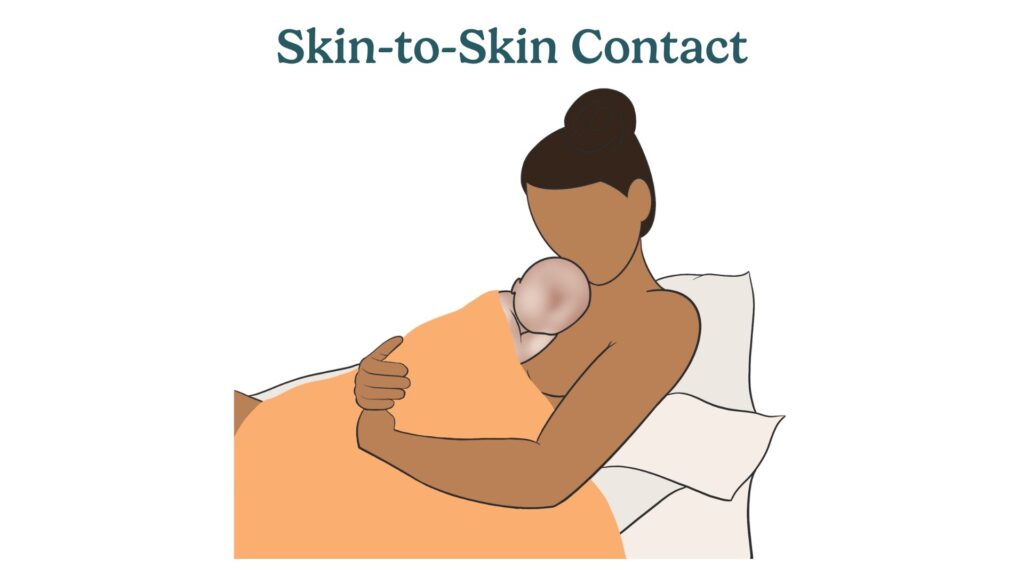skin-to-skin contact

Skin-to-skin contact
Skin-to-skin contact, also known as kangaroo care, involves holding your baby directly against your bare chest. This practice has numerous benefits for both the mama and the baby, promoting bonding, breastfeeding success, and overall well-being.
Blog post: Skin-to-Skin Contact with your Baby – The Who, What, Where, When, How, and Why
Blog post: The Importance of Skin-to-Skin Contact with your Newborn: Benefits, Breastfeeding, and Beyond
How to use skin-to-skin with your baby
It’s important to recognize the benefits of skin-to-skin contact and understand how to practice it effectively. Here are some considerations and tips:
Benefits
- Promotes bonding: Enhances the emotional connection between you and your baby.
- Encourages breastfeeding: Helps initiate and maintain breastfeeding by stimulating the baby's natural feeding instincts and the mama’s milk production.
- Regulates body temperature: Helps stabilize your baby’s body temperature.
- Improves heart rate and breathing: Supports the baby’s cardiovascular and respiratory stability.
- Reduces stress: Lowers stress levels for both mama and baby, promoting relaxation and well-being.
- Boosts immunity: Enhances the baby’s immune response by promoting the transfer of beneficial bacteria from the mama’s skin.
Steps for Practicing Skin-to-Skin Contact
- Prepare the environment: Find a quiet, comfortable place where you can relax with your baby.
- Remove clothing: Remove your baby’s clothing, leaving only the diaper on. Remove your top and bra, or wear a button-down shirt that can be opened easily.
- Position your baby: Place your baby upright against your chest, with their legs tucked up and their head turned to one side to keep the airway clear.
- Cover with a blanket: Use a blanket to cover both you and your baby, placing it at baby’s shoulders and ensuring the baby’s back is covered to maintain warmth.
- Relax and bond: Spend time relaxing, talking, or singing to your baby while maintaining skin-to-skin contact. Incorporate skin-to-skin contact into your daily routine, especially before and after breastfeeding sessions.
When to Practice Skin-to-Skin Contact
- Immediately after birth: Begin skin-to-skin contact as soon as possible after delivery to promote bonding and initiate breastfeeding. If possible, continue skin-to-skin for at least the first hour of baby’s life.
- Before and after breastfeeding: Helps stimulate the baby’s natural feeding instincts and improve milk let-down.
- During stressful times: Use skin-to-skin contact to soothe and calm your baby during periods of stress or discomfort.
- Throughout the day: Incorporate regular skin-to-skin sessions into your daily routine to maintain the benefits.
Precautions
- Safe positioning: Always ensure your baby’s head is turned to one side and their airway is clear during skin-to-skin contact. Don’t allow baby’s head to slump down.
- Monitor temperature: Be mindful of the room temperature and use a blanket to maintain warmth without overheating.
- Supervise baby: Sometimes the snuggles can make parents sleepy as well. The parent holding baby needs to remain awake, or the couplet needs to be monitored by another alert adult to ensure baby is in a safe position and will not fall.
Physical limitations or health circumstances
Certain conditions can influence the use of skin-to-skin contact:
- Premature birth: Skin-to-skin contact is especially beneficial for premature babies, promoting stability and growth.
- C-section delivery: If you have had a C-section, seek assistance from healthcare providers to practice skin-to-skin contact safely. Sometimes placing a pillow over your incision site can prevent discomfort during skin-to-skin. Read through our C-section recovery tips.
Other terms
Understanding related terms can help you better manage your breastfeeding and bonding experience with the support of skin-to-skin contact:
- Latch: The way your baby attaches to your breast. Skin-to-skin contact can help improve the latch. Read more about the first successful latch.
- Milk ejection reflex (let-down): The release of milk from the breast, often stimulated by skin-to-skin contact and relaxation.
- Kangaroo care: Another term for skin-to-skin contact, especially used in neonatal care for premature babies.
- Breastfeeding support group: A community of mamas who share experiences, offer support, and gain information about breastfeeding and bonding. Join our free breastfeeding support group.
- Lactation consultant: A professional who provides support and guidance on breastfeeding, helping to address challenges and promote skin-to-skin practices.


